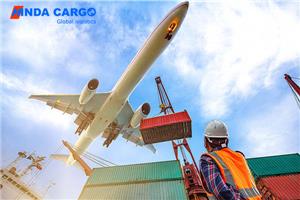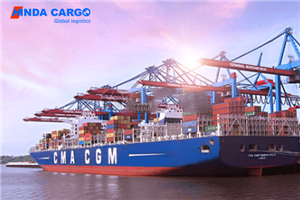How to innovate and develop Middle East air cargo?
According to the 2020 aviation industry data released by IATA recently, cargo is the highlight of air transport in 2020. In terms of scheduled freight ton-kilometres, Qatar Airways and Emirates in the Middle East are among the top five cargo airlines in the world, second only to the US express giants FedEx and United Parcel. After the outbreak of the new crown pneumonia, how did airlines in the Middle East innovate and develop air cargo business?
Demand continues to grow
According to the Commercial Market Watch report published in August 2021, the air cargo market size in the Middle East and Africa is expected to increase from USD 17.7 billion in 2021 to USD 27.82 billion in 2028, representing a CAGR of 6.7%. This could be good news for the global air cargo industry.
The Middle East is a dynamic market, and the interconnectedness of its countries makes it a very active region for air cargo. According to the World Economic Outlook Update published by the International Monetary Fund in July 2021, the Middle East and Central Asia economy is expected to grow by 4% in 2021 and 3.7% in 2022. Due to its "crossroads" location close to several of the world's largest manufacturing markets, the Middle East has established itself in a strategic position in the international logistics industry.
According to IATA, Middle Eastern airlines’ international cargo volumes in June 2021 increased by 17.1% compared to June 2019, but international capacity in June was 9% lower than in the same period in 2019. While exports of perishable goods, personal effects and oil and gas continued to grow, so did the Middle East’s e-commerce, Covid-19 vaccine and large-scale project cargo shipments.
Colston De Bruyne, Senior Vice President, Sales and Network Planning, Qatar Airways Cargo, said: “The growth of the cargo industry has been driven by strong demand for the transport of perishable cargo since early 2021, followed by within the Middle East and Europe. Transportation of personal items and large-scale project cargo. From January to June 2021, 50% of the export commodities in the Middle East will be transported to Qatar, mainly from Beirut, Lebanon, Amman, Jordan, Dubai, UAE, and Muscat, Oman. Most are perishable goods."
Talking about the trends in shipping goods, De Bruyne noted: “We are seeing a surge in e-commerce shipments due to the significant shift in retail from offline to online. In addition, we also transship from Middle Eastern countries such as the UAE. Lots of Covid-19 vaccines."
Meanwhile, Hiranka Leo, managing director of Emirates Global Air Cargo, a subsidiary of ECS Group, said that in the UAE cargo market, e-commerce and international trade are developing steadily. "E-commerce and online shopping have become the main drivers for smartphone users to go online, with increasing freight volumes on major routes from the Middle East to North America and the rest of Asia."
He also pointed out that in 2021, the manufacturing industry has not been greatly affected by the spread of the new crown pneumonia epidemic and is continuing to develop rapidly. “Companies are actively turning to air transportation to start production lines and deplete inventories as soon as possible to meet the growing market demand for export commodities. During the COVID-19 pandemic, there has been an increase in demand for commodities such as medical syringes, personal protective equipment, COVID-19 vaccines, oxygen cylinders, etc. ".
Narayan, Commercial Director, Etihad Cargo, said: “In addition to priority shipments related to Covid-19 vaccines and international aid, airfreight volumes continue to increase for e-commerce, consumer goods and perishables. Commodities requiring temperature-controlled transport, and Airfreight volumes of automotive products, rubber products and other raw materials have also seen significant growth." She also noted that demand in the Asian, European and US markets has increased significantly due to increased demand from the retail sector due to insufficient global inventories.
Lack of capacity and high freight rates
Global shipping capacity continues to be tight due to port congestion, production backlogs, container shortages and high freight rates, and the shipping situation remains grim. Narayan said: "As restrictions start to ease, high-end fashion brands need to replenish their inventory on a regular basis. With the disruption of ocean shipping, they have been relying on air freight." De Bruyne also said: "We are seeing customers increasingly rely on air. Ship the goods to meet the other party's requirements for transit time."
Freight demand on the Asia-to-US route is strong, and the Covid-19 pandemic has caused delays and shortages in ocean freight. However, during this period, ocean freight rates are high and transit times are full of uncertainty. "The disruption to ocean shipping is a boon for the air cargo industry, paving the way for increased profits," Rio added.
After the outbreak of the new crown pneumonia epidemic, due to the grounding of aircraft and plummeting passenger demand, passenger aircraft belly capacity has been severely affected. It can be said that the Covid-19 pandemic has cut the freight capacity available in the market by nearly half. Due to the lack of belly capacity on passenger aircraft and the growing demand for air cargo, Middle Eastern airlines naturally see this opportunity.
For example, in late March 2020, due to the impact of the epidemic, Emirates passenger services were forced to suspend, and the global capacity of the Emirates Sky Cargo Cargo Department dropped sharply. In the short term, only 11 Boeing 777 aircraft can be used to transport goods within the global route network. . However, Emirates SkyCargo moved swiftly to restart its global operations through initiatives such as "passenger-to-cargo" and managed to successfully fly between 100 destinations covering six continents within 100 days from March 25, 2020 Scheduled cargo flights resume.
De Bruyne said the belly capacity of wide-body jets is steadily recovering as passenger travel confidence recovers and global vaccination efforts accelerate. However, it remains below pre-COVID-19 levels, especially on transatlantic routes. “Even within the Qatar Airways network, we now only offer bellyhold capacity on flights to more than 140 destinations around the world. Due to insufficient cargo capacity, coupled with continued volatility in ocean operations and congestion at airports and ports, freight rates are full. At present, the freight rate in the Middle East has increased by more than 18% compared with 2020.”
Narayan noted that expanding the route network, increasing freighter utilization, converting passenger aircraft to freighter and utilizing the belly capacity of international passenger flights all contribute to maximizing air cargo capacity. “However, the current supply of capacity is still below the level before the outbreak of the new crown pneumonia epidemic, and the demand for freight has exceeded the supply of capacity. Therefore, the freight rate is high and higher than the level before the outbreak. Moving to air freight, we expect rates to remain at this level in the short term. Freight rates from Asia, Europe to the U.S. have seen double-digit increases due to ongoing capacity constraints.”
"Golden Triangle" Strategy
The outbreak has severely impacted Middle Eastern airlines' flight plans and the types of aircraft they operate. To this end, Middle Eastern airlines have had to adjust flight schedules and deploy additional capacity to meet growing cargo demand in certain markets.
For example, in 2019, Qatar Airways operated more than 107,000 flights, including 9,500 cargo flights; in 2020, a plunge in passenger demand led to fewer passenger flights, with 65,000 flights. To make up for the reduction in passenger flights, Qatar Airways increased its cargo flights to 11,000 in 2020 and added 12,000 more passenger-to-cargo flights.
Qatar Airways has become a leader in the cargo market by leaps and bounds. Between 2014 and 2019, the company saw a significant increase in capacity, with scheduled freight ton-kilometres increasing by 117%. However, 2020 marked another milestone for Qatar Airways: the company has become the largest cargo operator after FedEx and UPS.
Speaking to reporters, Qatar Airways chief executive Akbar Al Baker said: “We operate 40% more flights than our nearest competitor, and 28 more destinations. Although our average load factor It's only 40%, but we try to reduce operating costs by transporting enough cargo."
Qatar Airways took advantage of the lack of cargo capacity during the pandemic, making the most of its cargo and passenger fleets, even during the worst days of the pandemic. Doing so has a double benefit: sending millions of stranded travelers back to their own countries while earning much-needed income to weather the crisis.
De Bruyne said: "We are very proud of our 'Golden Triangle' strategy, a successful model created by the combined efforts of our revenue management, commercial network planning and freight teams. As a result, we have been able to do the most during the pandemic. fly and align the route network efficiently with our passenger and freighter aircraft (except 10 Airbus A380s).”
In addition, Qatar Airways Cargo has used Freightos' WebCargo air cargo e-booking platform to provide real-time and transparent capacity to freight forwarders through its global network in just six months. Since July 19, U.S. freight forwarders operating in multiple U.S. cities will be able to digitally check the Middle East carrier's routes, transit times and rates.
Narayan pointed out that the shortage of freighter aircraft is obvious considering that many airlines convert passenger planes into freighters. "The ability to maintain route profitability over the long term will determine whether airlines invest in more freighter aircraft." She also said they were looking at the Airbus A350 as an option in order to optimise Etihad Airways' product portfolio after the Covid-19 pandemic is over. Qatar Airways is also considering options for future freighters, which "urgently need more freighters and may become a launch user of new freighters". (Compiled by Xue Fei)
extend
Cargo fuels growth for Etihad Airways
Etihad Airways has released its operating results and financial report for the first half of 2021. The report shows that Etihad Airways has achieved steady business growth amid a slower-than-expected recovery in the global air travel industry, thanks to good results from its cargo business.
In the first half of 2021, Etihad Airways carried 1 million passengers with an average load factor of 24.9%. Since the beginning of this year, the company has opened or resumed a total of 10 routes, including a historic launch to Tel Aviv, Israel, in April this year. As of the end of June this year, Etihad Airways operated nearly 3,500 monthly flights to 67 passenger and cargo destinations.
Etihad Airways' passenger revenue in the first half of 2021 was only US$300 million, down 68% year-on-year, as the mutated coronavirus strain affected key travel markets in the Indian subcontinent and Europe. However, the decrease in passenger revenue was offset by a strong performance in the cargo business. In the first half of 2021, Etihad Airways' cargo volume increased by 44% year-on-year; cargo revenue increased by 56% year-on-year to US$800 million. After continuous cost control, the company's core business operating loss in the first half of 2021 was US$400 million, a year-on-year reduction of half; EBITDA turned from negative to positive, from negative US$100 million to US$100 million.
Tony Douglas, Group Chief Executive, Etihad Airways, said: "Etihad Airways strives every day to regain lost ground. While the spread of delta strains has disrupted the recovery of the global aviation industry, we continue to accelerate recovery. We are in a much better position now than this time last year. We see that once a destination is included in Abu Dhabi's 'green list' or establishes a 'travel corridor' with the UAE, ticket bookings will triple ~6 times, which shows that there is huge demand waiting to be released.”
As a founding member of Pakatan Harapan, Etihad Airways transported a large number of Covid-19 vaccines in the first half of this year, and became the first airline in the world to vaccinate all crew members against Covid-19, contributing to the global vaccination effort. To date, Pakatan Harapan has distributed more than 65 million doses of vaccines to 40 countries and regions in the Middle East, Africa, Europe, Asia and South America.
Meanwhile, Etihad Airways' PharmaLife product, which provides a best-in-class solution for the air transport of temperature-controlled pharmaceuticals, saw shipments grow by 94% compared to the first half of 2020. In order to solve the urgent need for insufficient cargo capacity, the company temporarily converted five Boeing 777 aircraft into freighters and operated more than 430 cargo charter and scheduled cargo flights.
Since the beginning of this year, Etihad Airways has also continued to launch new digital products or services to facilitate passenger travel and help the recovery of the global tourism industry. In January, the company partnered with IATA to trial the IATA Travel Pass; in May, it launched a home check-in and air travel verification service.




